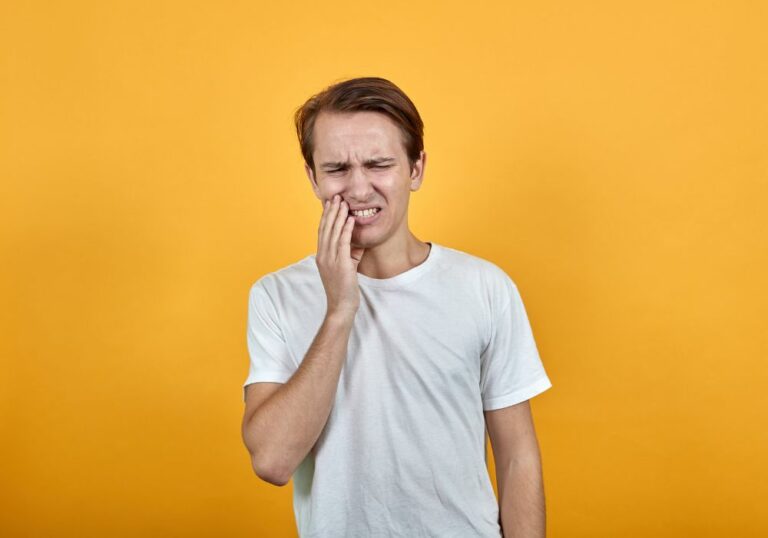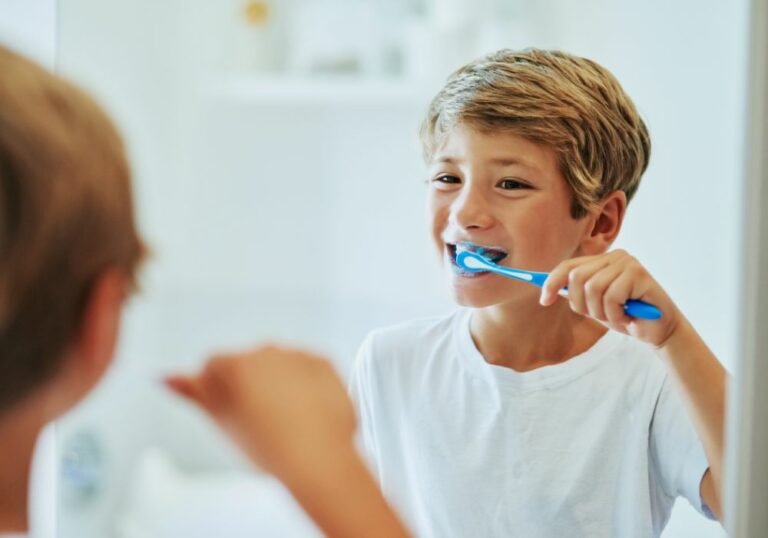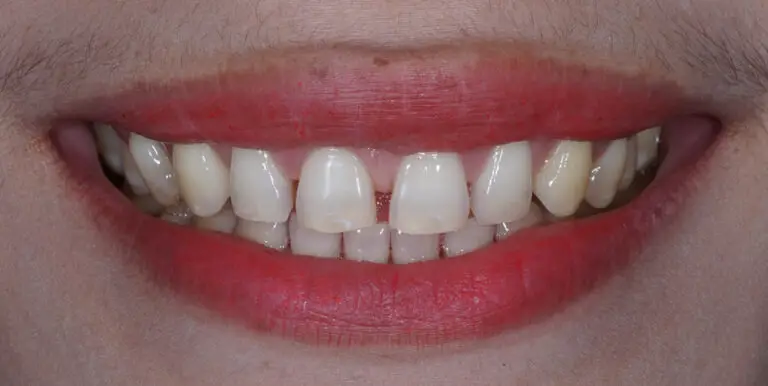Pregnancy brings about many changes in a woman’s body as it nurtures a growing baby. One common complaint is teeth turning brown or developing unsightly discoloration. This can add stress during an already emotionally and physically demanding time. Understanding the causes, best prevention methods, effective remedies, and when to seek professional help can help pregnant women maintain bright, healthy smiles.
The Causes of Teeth Discoloration During Pregnancy

Teeth stains and brown spots appearing during pregnancy have several possible originating factors. Being aware of these can help women anticipate and address changes proactively.
Hormonal Changes
When a woman becomes pregnant, hormones like estrogen and progesterone increase substantially. Estrogen levels alone can increase by more than 1,000%! These hormones target receptors throughout the body in order to support fetal development.
Unfortunately, they also affect gum tissues in the mouth. The hormones make gums more sensitive and inflamed while also increasing blood flow. This provides an optimal environment for plaque composed of bacteria to accumulate on teeth.
Plaque buildup can then instigate gingivitis, which is inflammation and bleeding of the gums. If left untreated, it can advance to periodontal disease which damages tissues and bone supporting the teeth. The plaque also interacts with mineral components in saliva to form tartar. Both plaque and tartar then lead to yellowish-brown staining on tooth surfaces.
Hormonal fluctuations continue throughout pregnancy, making women more susceptible to staining and discoloration of teeth the longer they are pregnant unless preventive steps are taken.
Morning Sickness
Nausea and vomiting affect up to 90% of pregnant women, especially during the first trimester. When stomach contents including gastric acids repeatedly come in contact with teeth, the enamel on the surface becomes eroded.
Enamel is the protective outer layer of the tooth composed of hydroxyapatite crystals that give teeth their whitish translucency. Once enamel wears away, the softer yellowish dentin underneath becomes exposed. This results in permanent intrinsic staining and discoloration.
Furthermore, the increased acidity in the mouth from morning sickness encourages extrinsic staining by altering pH levels on the enamel surface.
Changes in Oral Hygiene Habits
Fatigue, stress, and increased time demands often lead expectant mothers to overlook or slack on their usual oral hygiene regimen. Brushing and flossing may become more sporadic. Some women also develop an aversion to minty flavors, making toothpaste unpleasant.
Additionally, the importance of professional cleanings every 3-6 months is often undervalued during pregnancy. Avoiding the dentist’s chair can allow significant buildup of tartar, plaque, and stains to occur, especially below the gumline and between teeth.
Neglecting thorough brushing, flossing, and routine dental cleanings makes teeth much more prone to discoloration during pregnancy. Making oral care a priority can help counteract this.
Dietary Changes
Food cravings and aversions during pregnancy often change a woman’s normal diet. Some expectant mothers consume far greater amounts of staining foods and beverages such as coffee, tea, red wine, soda, and dark berries. Acidic foods like citrus fruits can also promote enamel erosion.
Additionally, dry mouth is a common symptom tied to hormonal shifts, dehydration, and side effects of medications. Saliva maintains a neutral pH in the mouth, washes away food debris, and remineralizes enamel. Insufficient saliva allows acids to literally eat away at tooth enamel and expose dentin. Having too little saliva leads to extrinsic staining.
Pregnant women should be mindful of tooth-staining foods and make an effort to consume those that increase saliva flow instead.
Use of Tetracycline Antibiotics
Tetracycline antibiotics like doxycycline may be prescribed during pregnancy to treat bacterial infections. If these drugs are taken after the age of 8 while teeth are still developing beneath the gums, they can permanently bind to calcium within the teeth themselves. This causes intrinsic grayish-brown discoloration that cannot be reversed externally.
Children should avoid tetracycline for this reason. Women who took it as kids are more prone to tooth darkening from tetracyclines if prescribed when pregnant. Ask your doctor about alternative antibiotics if possible.
When Does Pregnancy Teeth Staining First Occur?
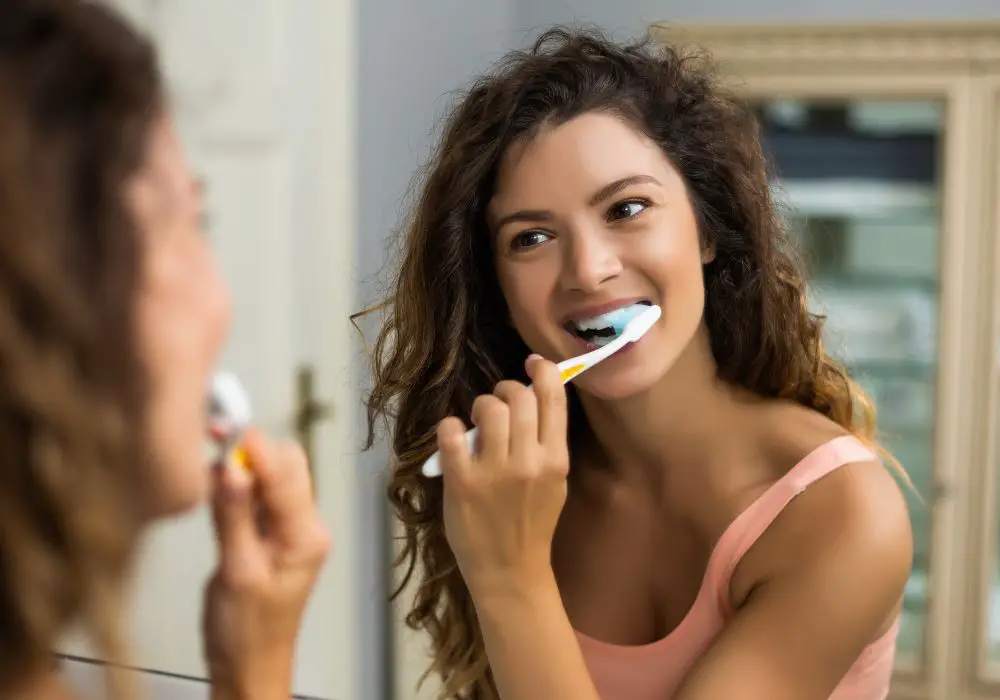
Discoloration and brown spots can begin at any stage during gestation:
- First trimester – Hormone surges start right at conception so gums become inflamed and plaque accumulation begins very early on. Nausea and vomiting from morning sickness also peaks in month 4 for most women.
- Second trimester – While hormones level out briefly early in the second trimester, they soon spike again. Continued vomiting plus structural changes in teeth increase risk of enamel erosion and gingivitis flare-ups.
- Third trimester – Teeth sensitivity, gum swelling and bleeding, increased tartar, and acid reflux are most likely to peak in months 8-9 leading to worsening stains down the homestretch.
While it’s impossible to predict exactly when pregnancy discoloration will present, it tends to worsen progressively unless proper oral hygiene is maintained diligently throughout all three trimesters. Advance planning and proactive care is best.
Can Pregnancy Teeth Staining Be Prevented?
Diligent oral hygiene during pregnancy can help minimize or potentially avoid teeth staining altogether. While some factors like hormones and morning sickness can’t be entirely controlled, being proactive reduces risk significantly.
Brush and Floss Thoroughly
Meticulous plaque removal is vital. Brush gently twice per day for a full two minutes using fluoridated toothpaste. Pay close attention to the gumline where staining bacteria accumulate most. Floss daily as well to dislodge plaque between teeth.
Use Whitening or Enamel-Strengthening Toothpaste
Look for toothpastes containing surface-polishing silica or baking soda to gently lift some extrinsic stains with regular brushing. Fluoride strengthens enamel to resist acid erosion. Some brands also contain compounds that inhibit bacterial growth and tartar formation.
Rinse Daily with Antiseptic Mouthwash
Swishing daily with antibacterial mouthwash reduces gum inflammation and supernatant plaque that leads to staining. Using mouthwash prevents gingivitis which is closely tied to tooth discoloration.
Eat Tooth-Friendly Foods
Focus diet on fruits, vegetables, dairy products, lean proteins, nuts, and grains that fight stain acids and fuel saliva flow. Limit sugary and acidic choices. Drink plenty of water to prevent dry mouth. Take prenatal vitamins containing enamel-strengthening calcium, vitamin D, vitamin C, and vitamin K2.
Get Professional Cleanings
See your dentist for a thorough deep cleaning every 3-6 months to remove plaque buildup you can’t reach with home care. Regular professional cleanings are the best prevention against pregnancy dental stains.
Avoid All Tobacco Products
Smoking or chewing tobacco is awful for oral health both topically and systemically. The carcinogens not only intrinsically stain teeth and promote gum disease, but also restrict blood flow to gum tissues. Using tobacco during pregnancy should be avoided completely.
Making these positive oral health choices before and throughout pregnancy can dramatically minimize the chance of unsightly yellowing or brown teeth.
Home Remedies to Lighten Teeth Stains

If teeth do end up developing some discoloration during pregnancy, there are several natural home remedies that may help:
- Baking Soda – Mix baking soda with water or hydrogen peroxide into a spreadable paste. Gently brush it onto stained teeth for 1-2 minutes then rinse thoroughly. Its mild abrasive texture scrubs away built-up surface stains without damaging enamel. Using it 1-2 times per week helps whiten teeth.
- Hydrogen Peroxide – Swish pure 3% hydrogen peroxide around the mouth for 60-90 seconds allowing it to bubble and penetrate stains. Then rinse well with water. The oxidizing bubbles release stain molecules. However, peroxide can irritate sensitive pregnancy gums so discontinue use if any pain.
- Lemon Juice – Rub a lemon wedge or cotton ball soaked in fresh lemon juice over stained teeth. Let sit briefly before rinsing. The high citric acid content acts as a natural bleach against organic stains. But go easy on abrasive brushing as the acid can erode enamel over time.
- Apple Cider Vinegar – Some claim swishing with apple cider vinegar removes extrinsic stains with consistent use over time. Dilute with equal parts water before swishing to minimize acidity. Results vary from person to person so try it cautiously.
- Crunchy Fruits and Vegetables – Chewing on apples, celery, carrots, etc. mechanically scrubs teeth while also stimulating saliva flow to wash acids and debris away. Their vitamin C and water content strengthen and remineralize enamel as well. Just beware excess citric acids.
- Strawberries – Their malic acid can help dissolve and lift away discoloration on the enamel surface. Mash them into a paste and brush gently onto teeth 2-3 times per week, rinsing afterwards.
Natural remedies require diligence and patience but can improve mild to moderate pregnancy stains before considering professional whitening. However, avoid overusing acidic ingredients that might erode enamel further.
When to Visit the Dentist for Stain Removal and Whitening
For pregnant women with:
- Severe brown staining or stubborn intrinsic tetracycline discoloration
- Sudden formation of white, brown, or black spots
- Increased tooth sensitivity and pain
- Receding, sore, or bleeding gums
- Any signs of infection or decay
Visiting a dentist promptly for an exam is advised. The dental team has the professional experience, tools, and whitening products to thoroughly remove tenacious stains while identifying any underlying problems requiring treatment.
Professional Teeth Whitening Options During Pregnancy
Over-the-counter whitening toothpastes and strips with lower concentrations of bleaching agents are considered safe for expectant mothers. However, higher dose treatments should be postponed until after delivery.
In-Office Bleaching
In-office whitening applies concentrated peroxide gel to teeth and uses light or laser energy to accelerate the chemical reaction. While fast acting, softened gum tissues can become irritated. Potential heat and light exposure risks to a developing baby also exist. Best to wait until after birth.
Take-Home Whitening Trays
Custom-fitted trays allowing overnight bleaching with stronger peroxide gels are another option that provides dramatic results. But extended exposure concerns mean dentists typically recommend delaying use until the postpartum period.
Other Chemical and Micro-Abrasion Methods
Newer stain removal techniques like silver nitrate or air abrasion that strip intrinsic stains using caustic chemicals, micro-particles or high pressure are also avoided until after pregnancy and breastfeeding are complete.
Play it safe by focusing on extrinsic stain removal and sticker with over-the-counter whitening products for best results before baby arrives. For obstinate stains, professional cleaning is the safest choice.
Are Pregnancy Stains Permanent?
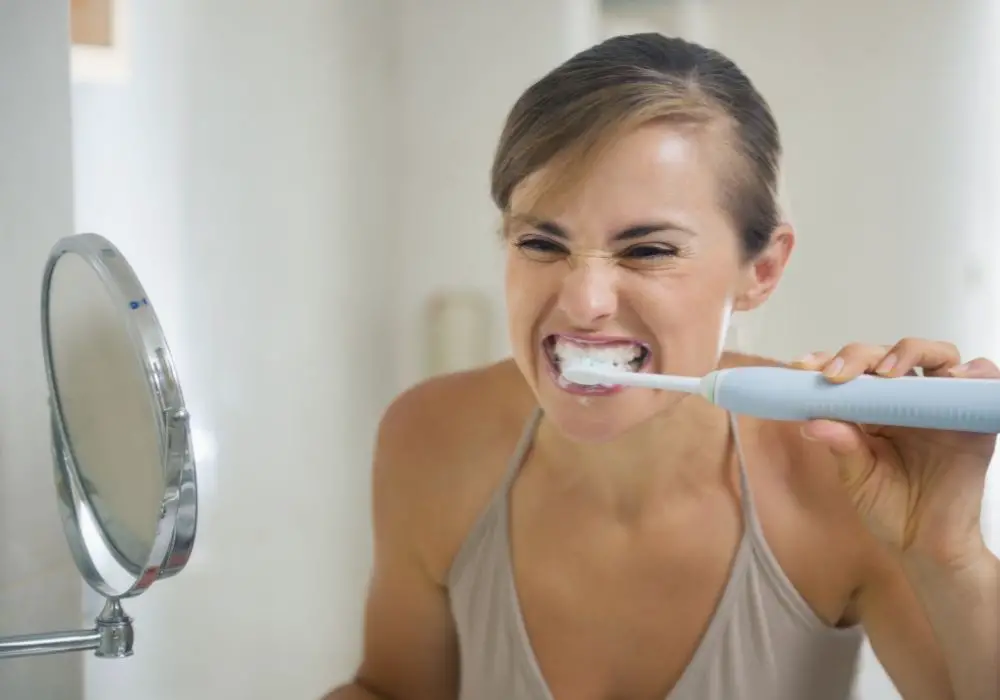
For extrinsic staining limited to the enamel surface, persistence depends largely on whether good oral hygiene is maintained during and after pregnancy.
Hormonal Changes Resolve
Gum inflammation and sensitivity improves after giving birth once hormones normalize. This facilitates better plaque control.
Morning Sickness Dissipates
Losing the nausea and acid reflux minimizes further enamel erosion and staining.
Oral Habits Often Improve
Many new mothers are vigilant about good diet and hygiene wanting to set a healthy example for baby.
Intrinsic Staining Won’t Resolve
Discoloration to dentin from tetracyclines or micro-cracking is permanent. Otherwise, diligent brushing, professional whitening and cleaning can restore a bright smile.
While pregnancy itself doesn’t inherently cause lifelong staining, staying on top of oral health afterward is key to reversing temporary discoloration issues.
In Summary
It’s common for pregnancy hormones, vomiting, dietary changes, and lapses in oral hygiene to instigate teeth discoloration – but not inevitable with diligent care. Strategic use of dental products, natural remedies, professional cleanings, and postponing intensive treatments until after delivery can help new mothers maintain healthy, white smiles.
Stick to a daily proactive regimen of brushing, flossing, rinsing, and chewing crunchy produce. Seek dental advice promptly if stains don’t respond to OTC treatments or if pain, sensitivity or gum problems arise. With conscientious effort, you can keep your glowing smile as bright as your future with baby!
Frequently Asked Questions
Why do teeth sometimes stain brown during pregnancy?
Increased hormones cause gum inflammation and bleeding, allowing more plaque buildup. Stomach acid from morning sickness also erodes protective enamel, exposing yellowish dentin. Neglected hygiene and dietary acids contribute as well. The cumulative effect is extrinsic staining of teeth.
Should I get my teeth whitened professionally while pregnant?
Over-the-counter whiteners are fine but higher concentration bleaching gels used with in-office or take-home trays are typically postponed until after birth. Their safety for developing babies has not yet been conclusively established. Talk to your dentist about options.
Will teeth stained during pregnancy stay that way permanently?
Extrinsic staining limited to surface enamel can usually be removed with sufficient brushing, whitening treatments, and professional cleanings after pregnancy. Intrinsic tetracycline staining that binds within the dentin would remain permanently. Consistent oral care is key.
How can I prevent teeth discoloration before and during pregnancy?
Brush and floss thoroughly each day, chew xylitol gum, use antibacterial mouthwash, limit acidic and sugary foods and drinks, take oral health supplements, get dental cleanings every 3-6 months, avoid tobacco, and use OTC whitening toothpastes and strips.
What natural home remedies can help whiten teeth during pregnancy?
Baking soda, hydrogen peroxide, strawberries, lemon juice, apple cider vinegar, chewing crunchy vegetables, and coconut oil pulling are gentle ways to naturally lift extrinsic stains by abrading surfaces particles and supplying whitening acids. Just avoid overuse that might erode enamel.

